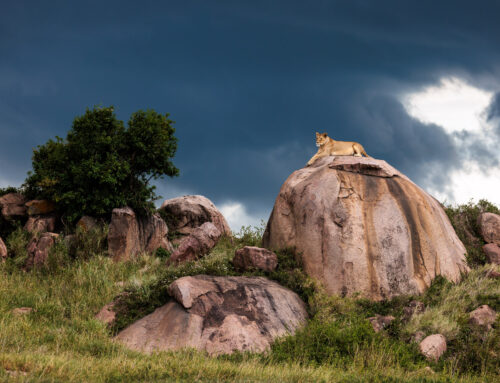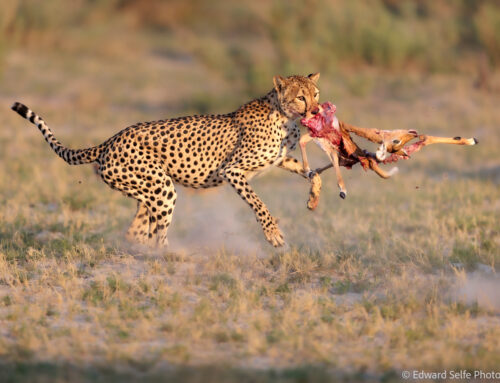October is always considered to be the peak safari month in South Luangwa. It’s hot, dry and there is a fantastic concentration of game along the river banks. It’s a time for safari purists who seek the greatest interaction of species, the best chances for sightings such as lions hunting buffalo, and don’t mind the early mornings and hot days that are required to achieve it. It’s elite safari.
I was excited to get started on this trip; we were promised almost two weeks of game sightings in the best areas of South Luangwa National Park, starting in the wild and private southern section, where the Bushcamp Company holds the concession on all the camps and offers an outstanding experience. After 4 nights here, we would move to Shenton Safaris’ Kaingo Camp in the northern part of the park which is a favourite of mine. And we’d finish with 3 nights at Nsefu Camp in the remote and quiet Nsefu Sector, where we hoped for a long-anticipated rendezvous with a particular leopard!
Joining me on this trip were 4 guests who had not travelled with me before: David & Ute are safari travel veterans and have explored many wonderful places across Africa and beyond. They had loved their previous visit to South Luangwa and wanted a rerun, but with the additional insights of the photographic safari element. Nathalie had visited the Nsefu Sector before and wanted to see more, and wanted to bring Charles to explore for the first time. They were exceptional guests and travel companions; sharing the highs and lows of the trip, rising early to keep to our timetable of pre-sunrise departures, and maintaining an awesome morale even when the hot days started to bite!
Predictably, the combination of our commitment to early starts, and the Luangwa’s incredible natural heritage delivered us an unforgettable trip. This is my 15th year in the Luangwa Valley and I still find events on a daily basis that make me wonder at the place. As before, here follows a visual record of the tour, but you can also see daily updates from the safari on my Instagram highlights – follow the link here.
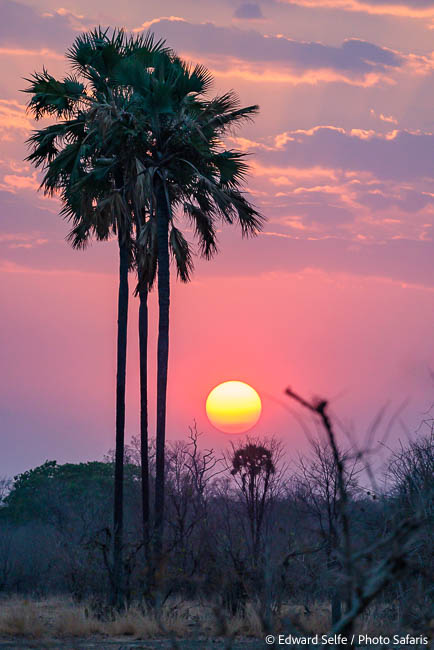
Our first afternoon was taken up with reaching Chindeni Bushcamp, via a tour briefing, and some lovely sightings on the way down; African jacanas at the water, greater kudu in the plains and this lovely sunset.
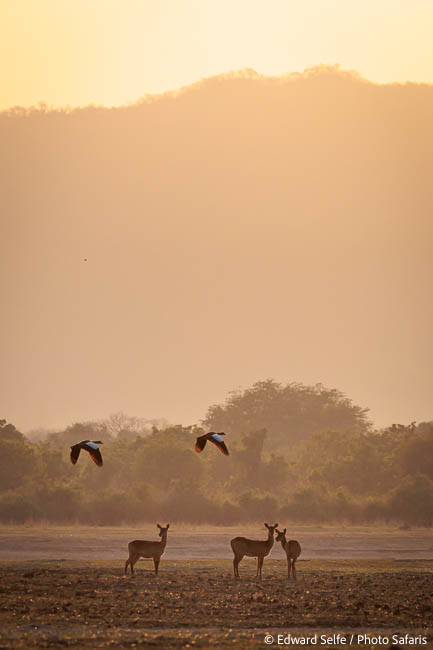
We arrived in the dark at Chindeni as expected, so it was not until the following morning that we could all see the beauty of the place. There had been some cloudy days just prior to the trip, so the light was clear and crisp, illuminating the hills in a way that I hadn’t seen in October.
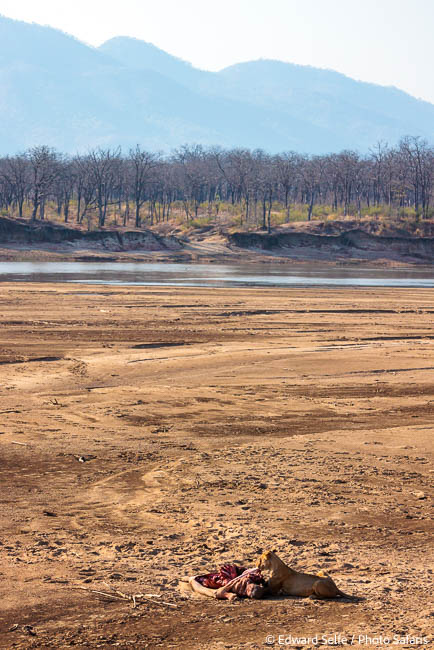
Our first headline sighting started on morning 1! Three male lions and a female had killed a young hippo on the beach, presumably when it was returning to the water with its mother. They were feeding on the sand in a scenic spot, but we knew that they would get too hot before long…
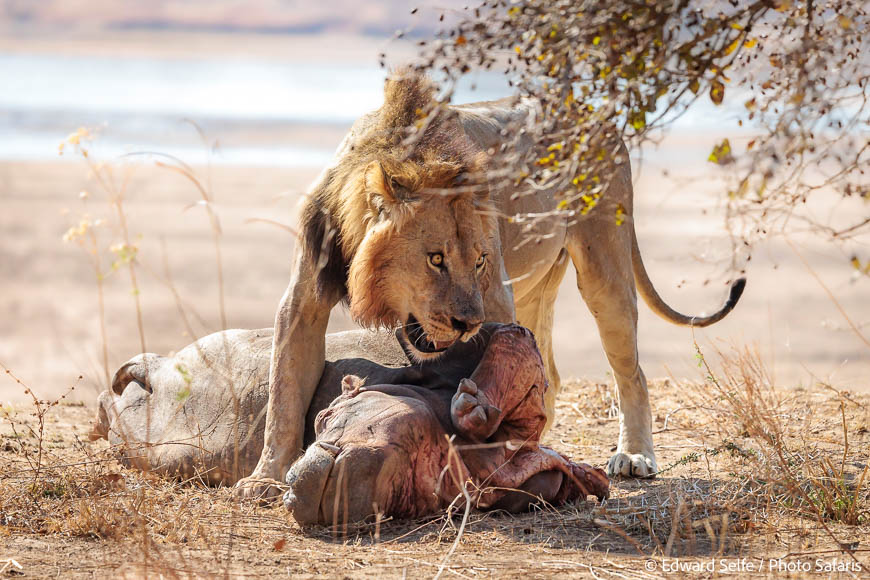
…and indeed they did. Collectively, with each lion carrying a part of the carcass, they dragged it up the near-vertical cliff, perhaps 6m high, and stashed it in the shade at the top. This male was the one who carried the bulk of the carcass in an astonishing show of power.
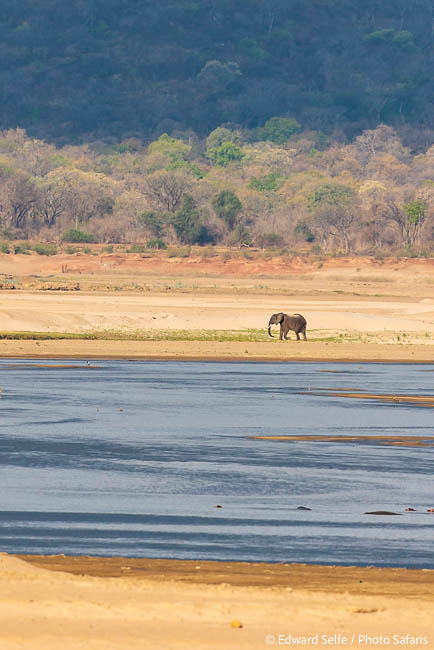
The clear air gave us a chance to show colours and contrasts in a way that I have only rarely seen so late in the season. Shooting over long distances, I offered ideas to the guests at a regular elephant crossing point. Being so small in the frame is not a problem when you have the distinctive shape as an elephant.
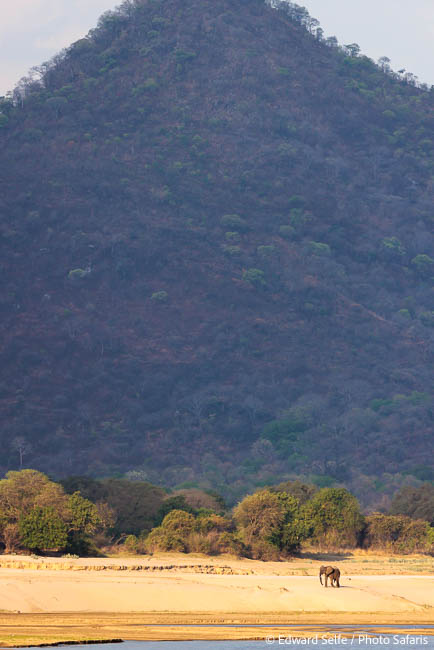
One of the Chindeni Hills’ peaks with a very small elephant on the beach below.
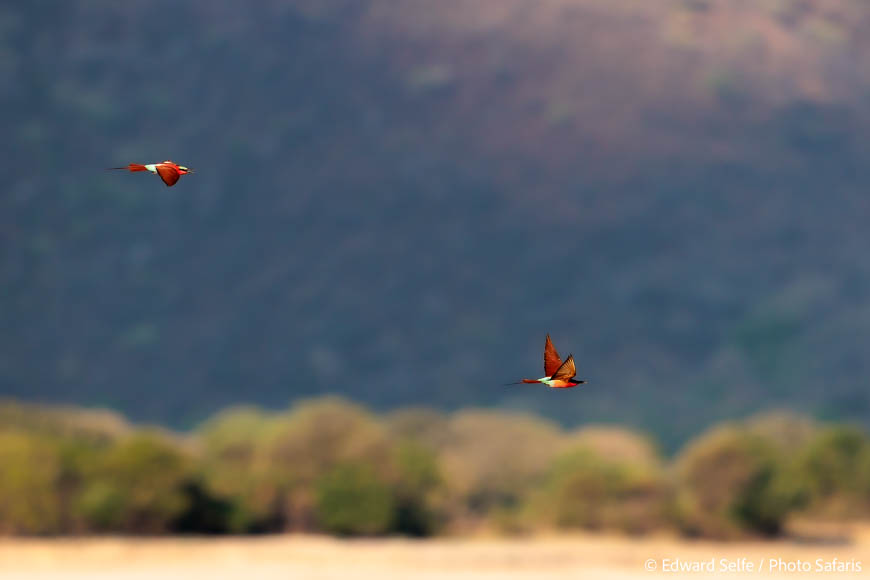
At the same elephant crossing point was a colony of carmine bee-eaters. The were very skittish and never let us close, but we took the chance to shoot them on the beach and when they flew up against the blue-purple colours of the shaded hills behind. It was a unique photo opportunity for me.
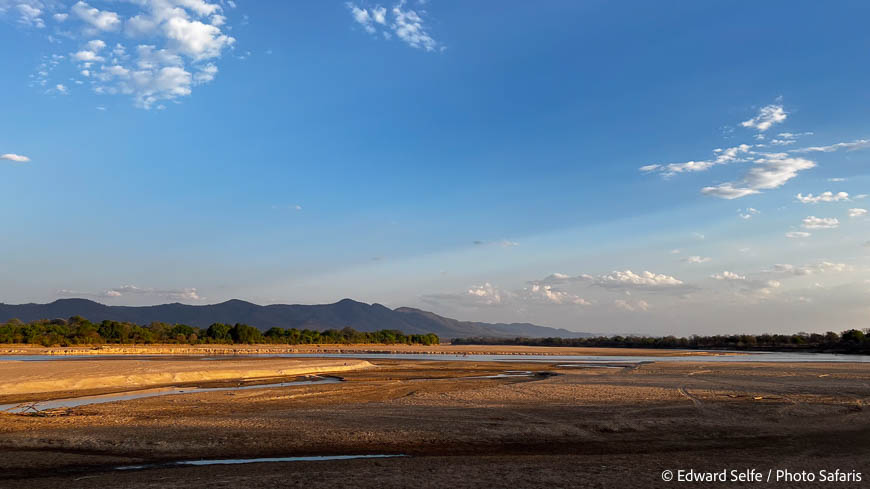
The landscapes around Chindeni are really spectacular.
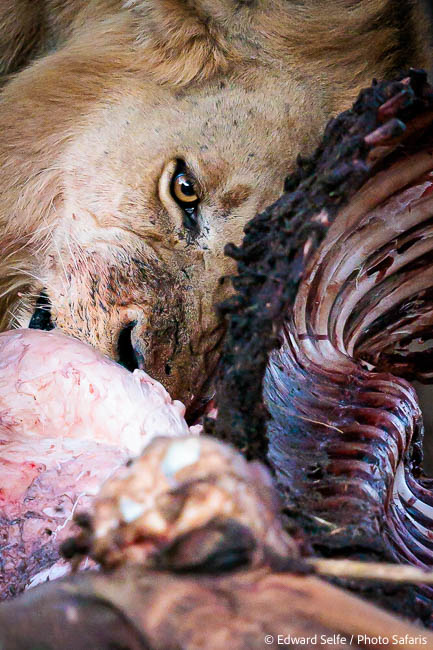
Heading home that evening, we stopped to see what the lions were doing. 3 were down at the water’s edge, beyond our reach, but one male was feeding on the carcass. It wasn’t a pretty sight but zooming in very tight made some interesting semi-abstracts.
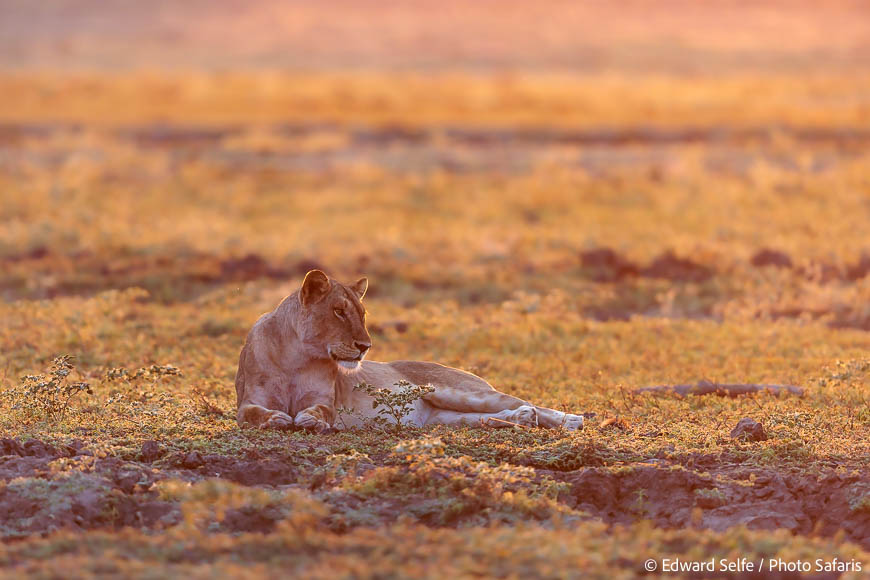
The following morning I could hear baboons calling on the floodplain in front of the camp. I sat with my coffee waiting for the light to come up enough to show me the cause. It was the Chindeni Pride; the rest of the females and the cubs who had not been at the hippo carcass. The light was fabulous for a short time before the females took the youngsters into the Mopane woodland behind the camp.
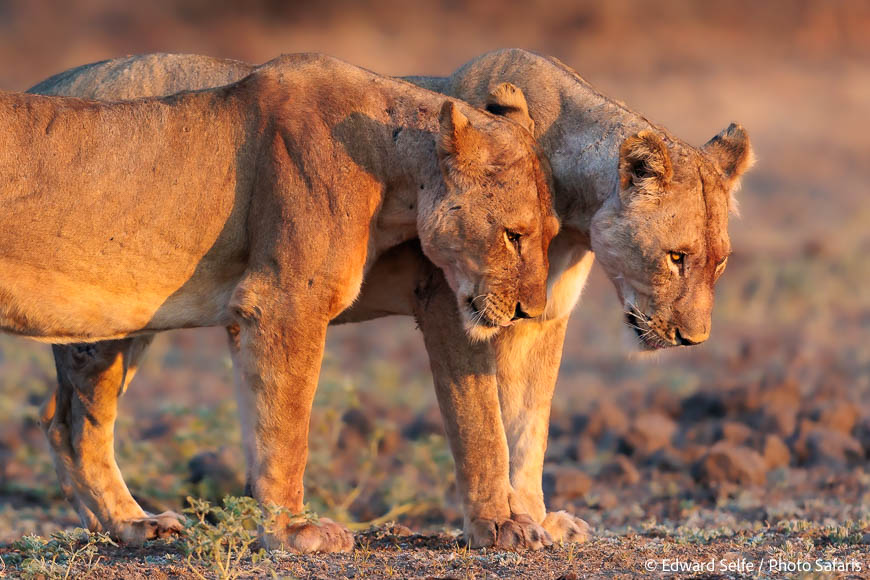
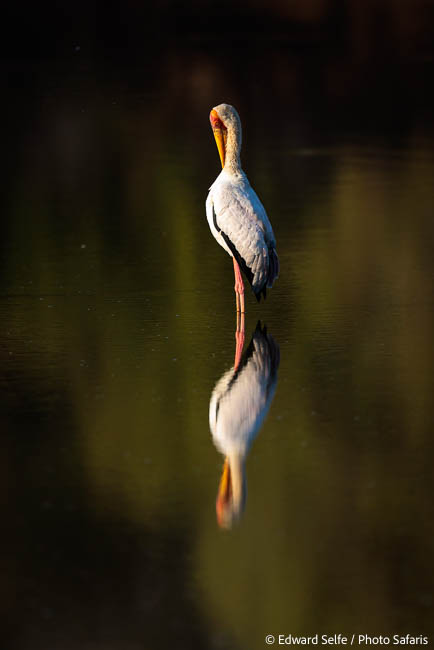
The light that morning was special; so instead of moving on, we spent a long time at Chindeni Lagoon – in front of camp – and photographed the water birds, including this yellow-billed stork which seems to be taking a quiet moment in prayer.
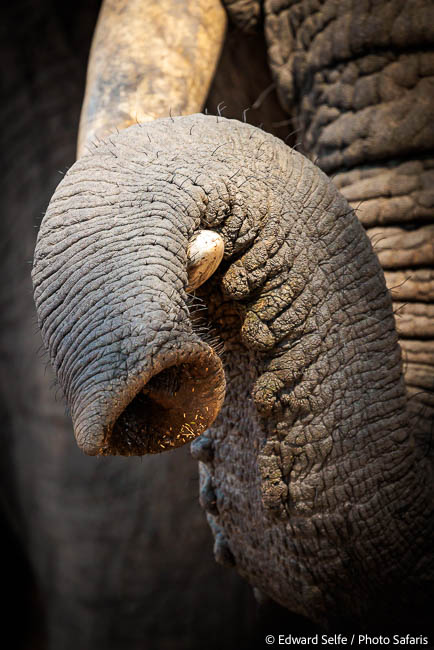
Later that morning, a mature bull elephant gave us a bit of adventure when he approached the vehicle very close….and then started to snooze… He carried his trunk on his tusk, giving some unusual shots.
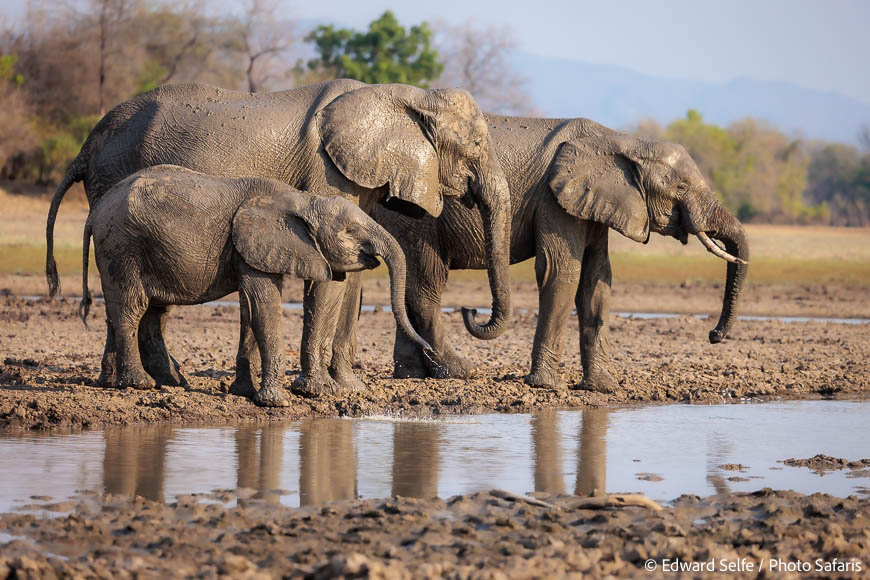
In front of camp in the afternoon…Chindeni’s setting is really superb with lots of the game right there using the lagoon in front.
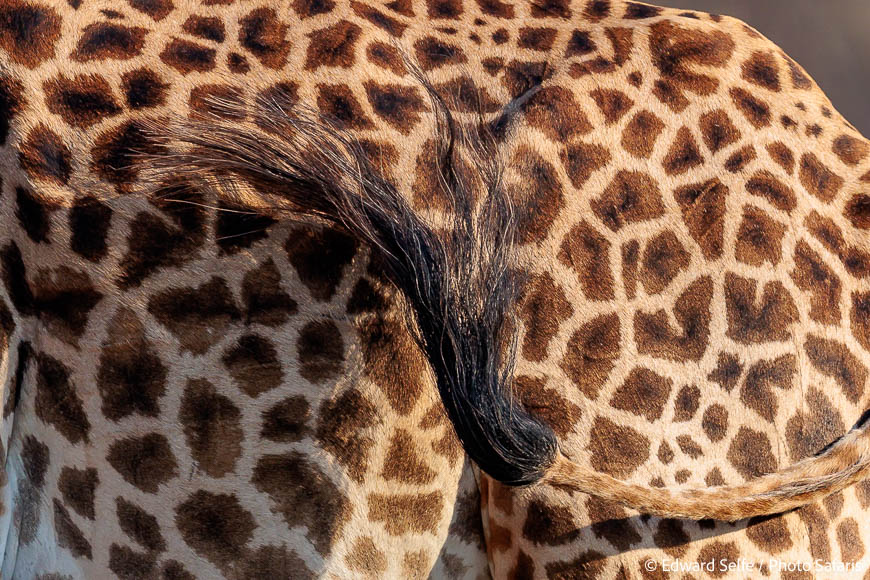
One request was to get “flat” shots of giraffe skin to compete a set of coasters, so I was always looking for an opportunity. This male giraffe was swishing flies which made great pics, but didn’t fulfil the remit!
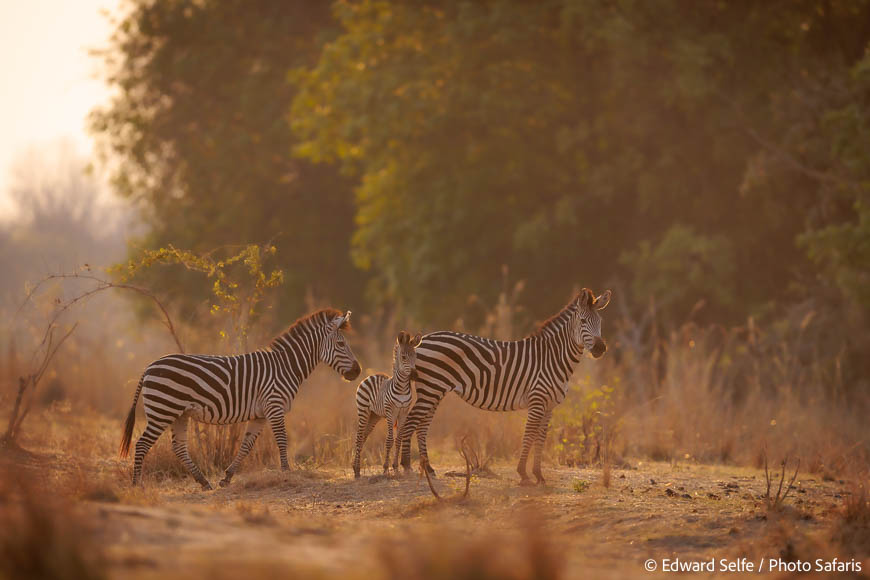
Late afternoon, on the Kapamba River, the light was spectacular with a golden wash on these backlit zebra.
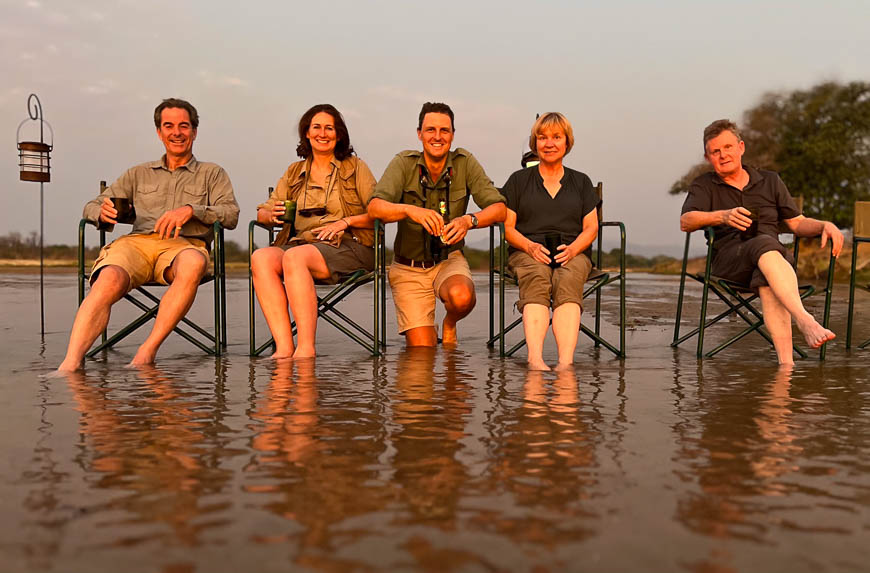
Sundowners with the team in the Kapamba River. Thank you to BushCamp Company for taking such good care of us!
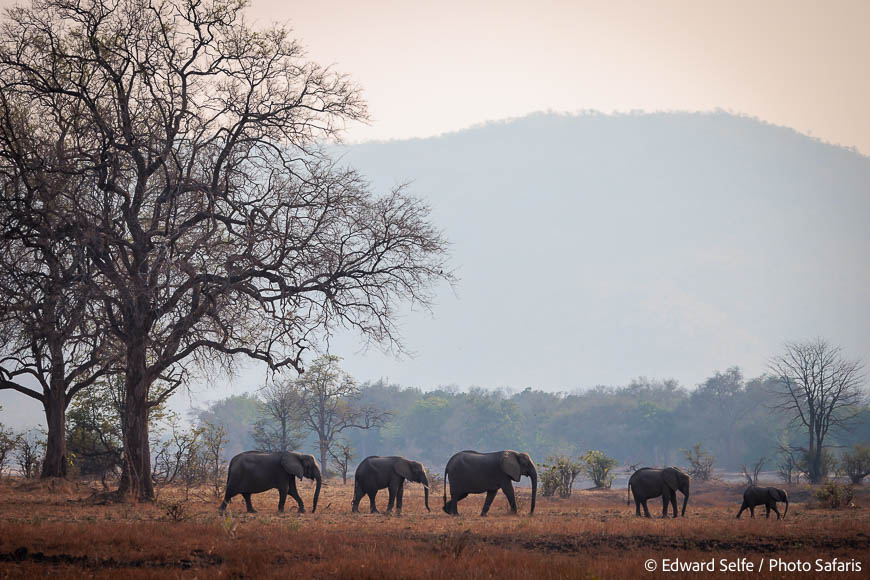
Leaving camp on our final morning, we had a wonderful safari; first a herd of elephants which crossed our path in an orderly line: note the very different body shape of the left-hand and the middle cows in this shot…interesting age- and genetic-based variation.
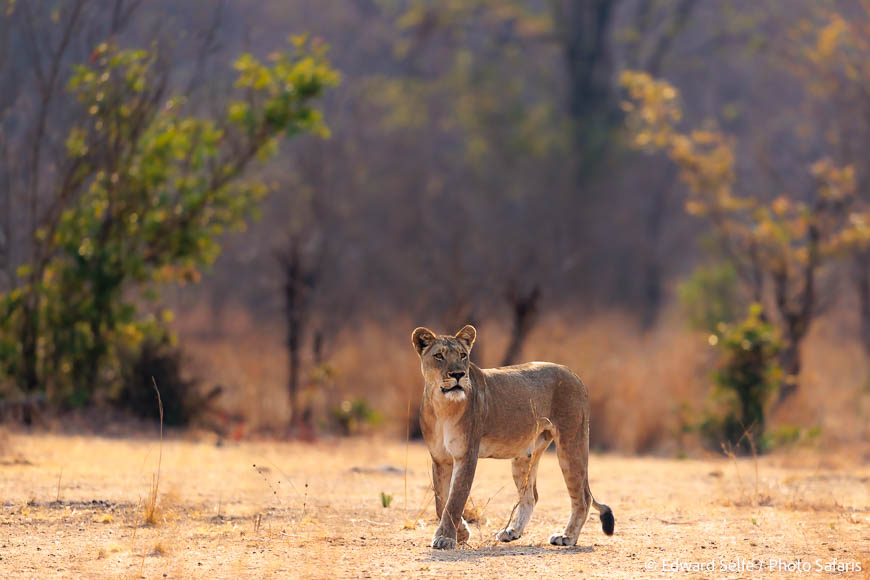
Unexpectedly, we met the Chindeni Pride once more…they were searching for prey and moved towards a large grass plain where they often find warthogs. They met a herd of elephants which chased them…and then one cow elephant seriously chased us too. We had to find an exit route and use it quickly. Misheck Milanzi, our guide, was superb, recognising the elephant as a troublemaker and acting fast to avoid any holes being made in the vehicle!
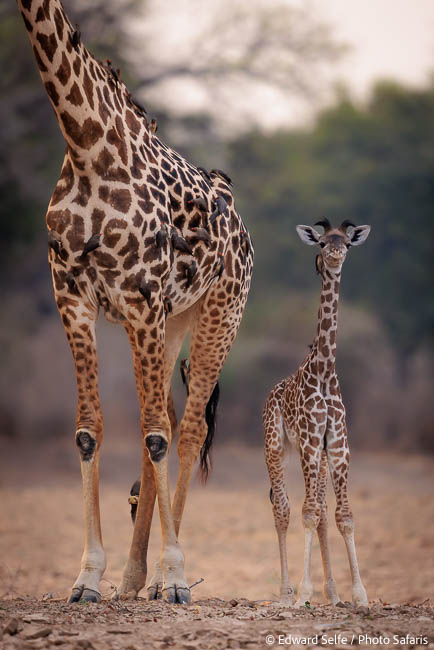
Arriving at Shenton Safaris, I was keen to get stuck into that northern part of the park which has been the core of my safari area for the last 8 years. I use either of Shenton Safaris’ two camps, or the outstanding Lion Camp, which all access the same area. Sightings came thick and fast immediately….
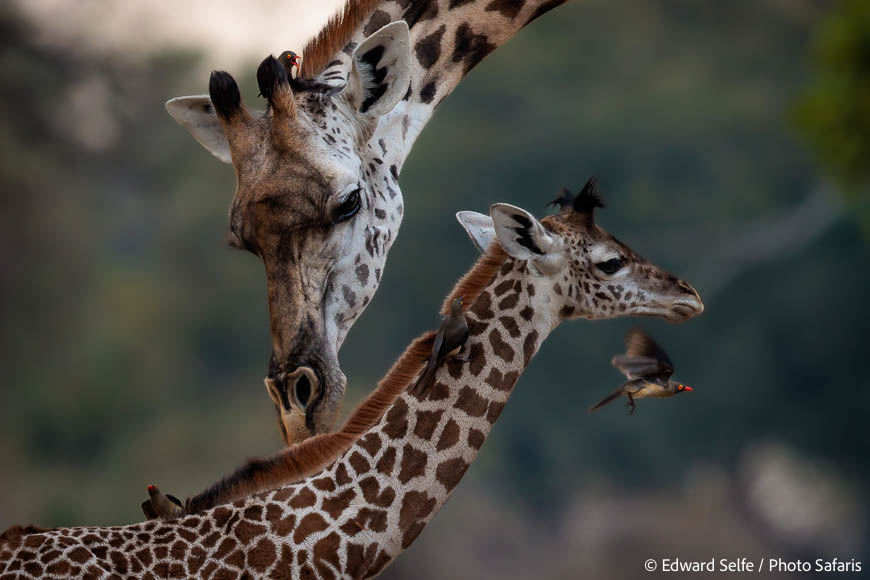
…including this young giraffe with its family…
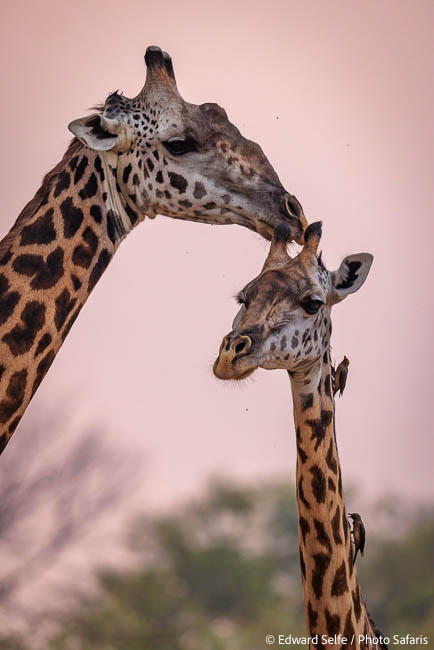
…and a very doting male who was affectionate towards the calf’s mother.
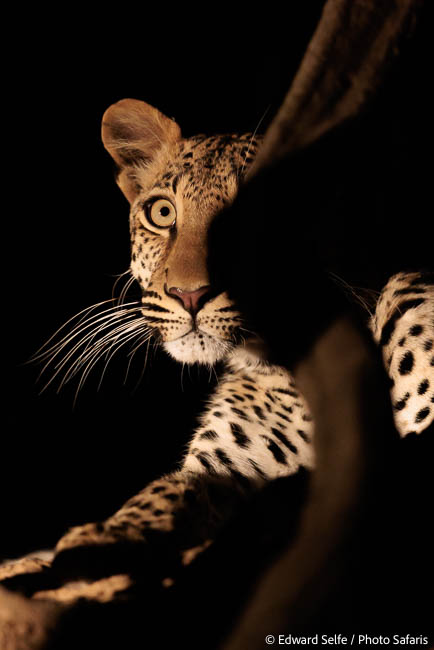
Leopards had been absent so far on this trip, which is very surprising for a Luangwa safari; but I knew that the Shenton Safaris area would make up for that. We located Taonga on the first evening; she slept a lot, but as darkness fell she awoke and gave us a chance to sidelight with another vehicle’s light. There were a number of creepers running across her which makes for an interesting effect. What do you think?
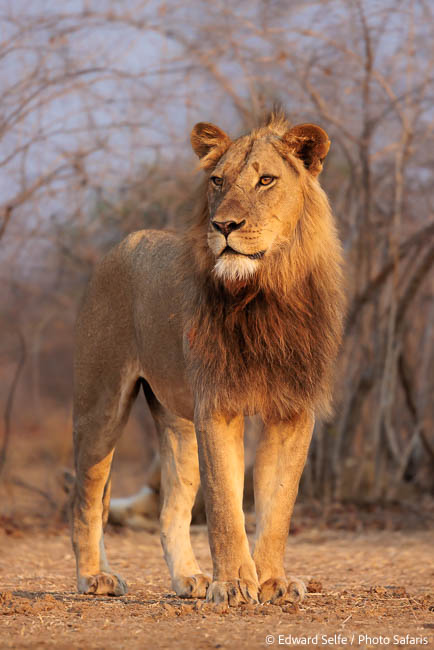
Then came the lions… So many wonderful sightings including the MK male with the mothers and cubs from that pride. We were able to get ahead of them and down into a channel, giving us ground-level views….
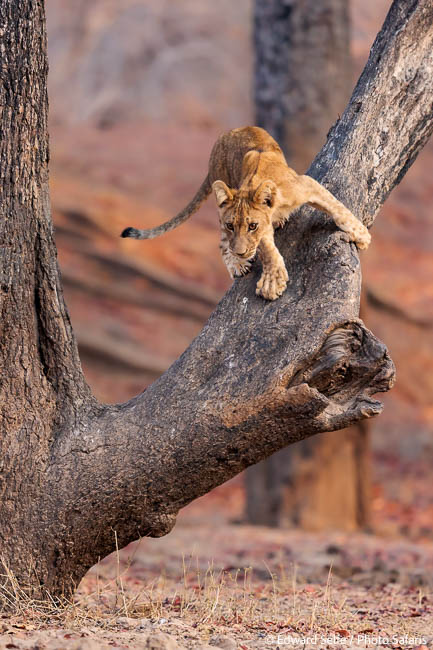
…and then interesting shots of the cubs who were climbing the large ebony trees.
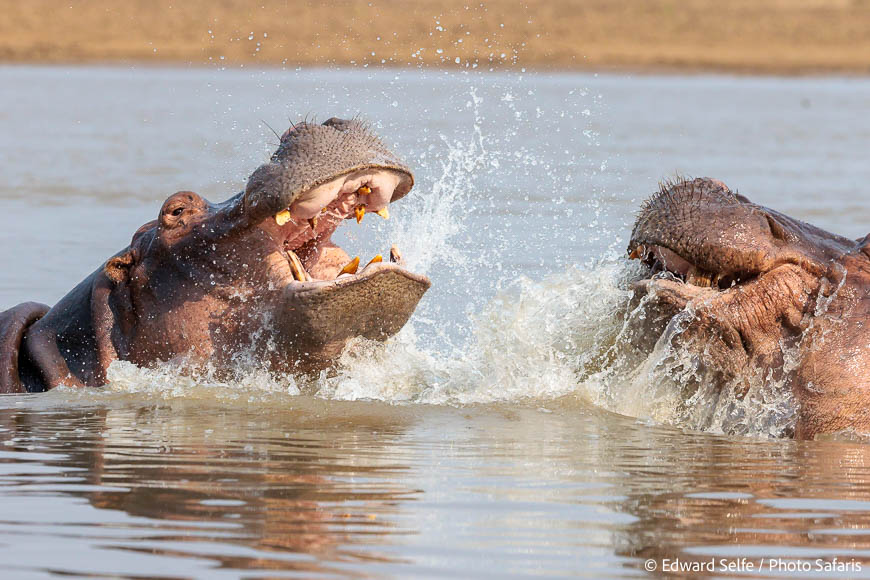
Shenton Safaris have a small network of photographic hides; the hippo hide is one that is reserved for Kaingo Camp guests and gives low, close views of hippos at the Mwamba-Luangwa River confluence. In the last 6 years, this hide has not been so productive as the water levels have been high, but it’s still fun to sit and watch, and there are occasional scuffles which are well worth the wait…if you are ready!
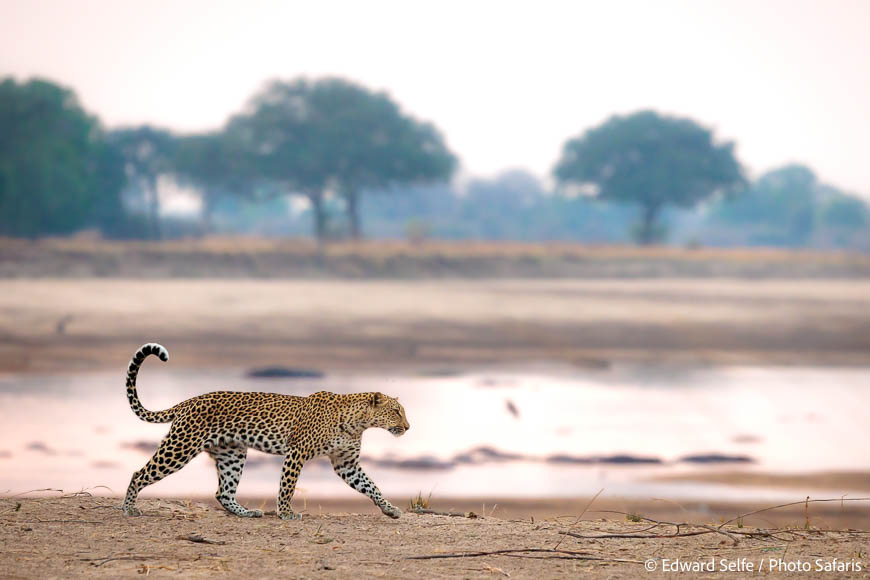
Up early morning once more and we very quickly spotted Taonga moving along the river bank. The pre-sunrise pink glow on the water was a great background and I kept a distance to ensure that everyone had a clear profile shape of the cat with her tail raised. Moving closer would have required a shorter focal length and, all other things equal, would have brought the hippos behind more in focus, distracting from the subject.
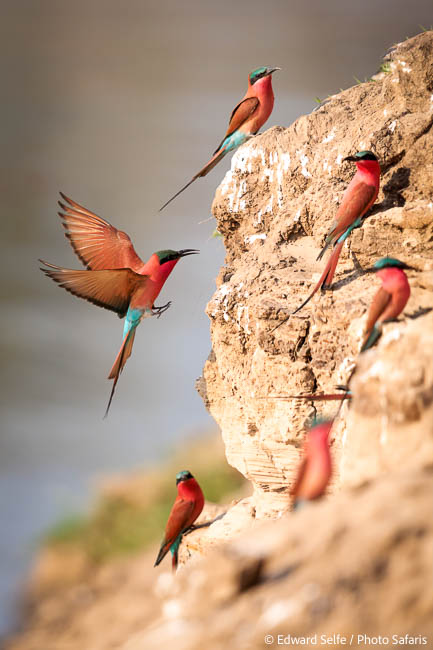
And now, to the carmine bee-eaters. There is a superb colony near Lion Camp which is totally habituated and allows us to sit on the bank alongside them and shoot along the cliff at the colony. I think this is the best angle to shoot the birds from as there is the chance to introduce artistic depth-of-field to the frame. Shooting at the bank, as some hides do, is far less appealing in my opinion.
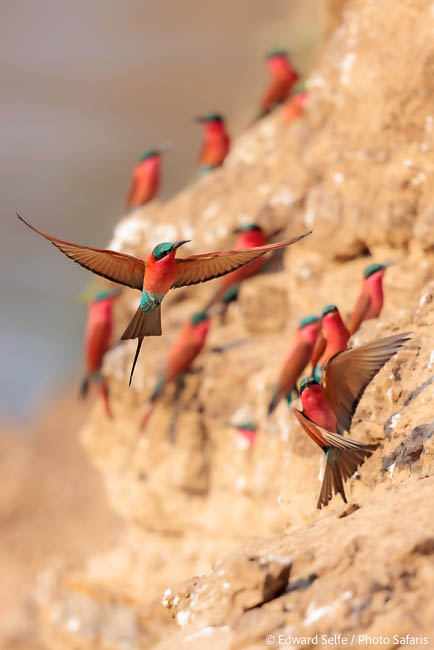
The tracking AF of the R5 is simply superb in this situation, combined with the 20fps electronic shutter. Comparing adjacent frames, it’s clear that with fast-moving birds the more frames the better as there is significant movement even between two frames at 20fps.
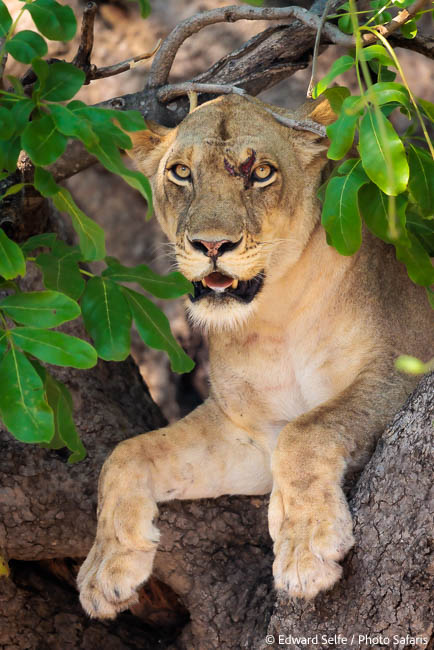
That night, the Hollywood Pride (near Lion Camp) killed a buffalo. We headed there in the early morning and found the pride feasting. Two of the youngsters were at a nearby tree…and one was up in the branches! It’s a fairly unusual scene in the Luangwa so we headed to that first!
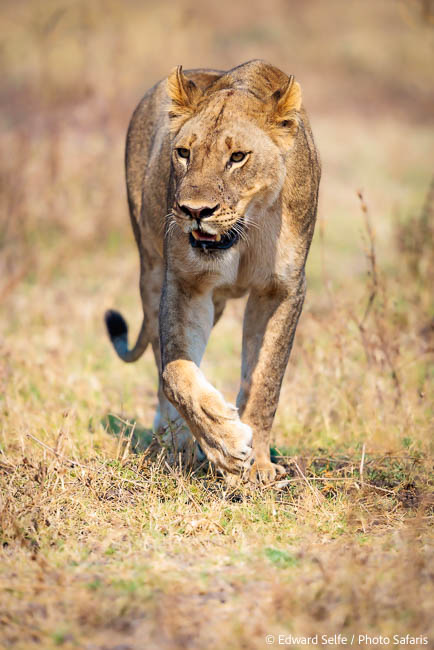
When the lioness descended, she joined her sister and they moved across the grassy plain towards the carcass. We moved ahead and took great images of them moving in the open.
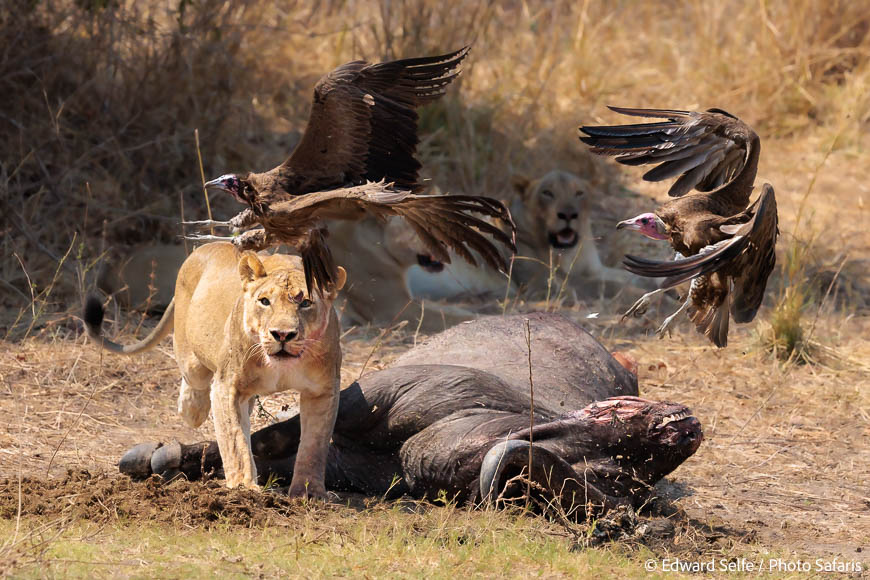
One of the lionesses was adamant that she wouldn’t share the kill with even a single vulture. Every time they landed on the carcass, she erupted from the shade and chased them off. Deciding where to focus, and how to capture the action is not easy, but we spent a happy hour trying! Avoiding clipping wingtips, or losing focus on the lion’s eyes are all pitfalls of this kind of image.
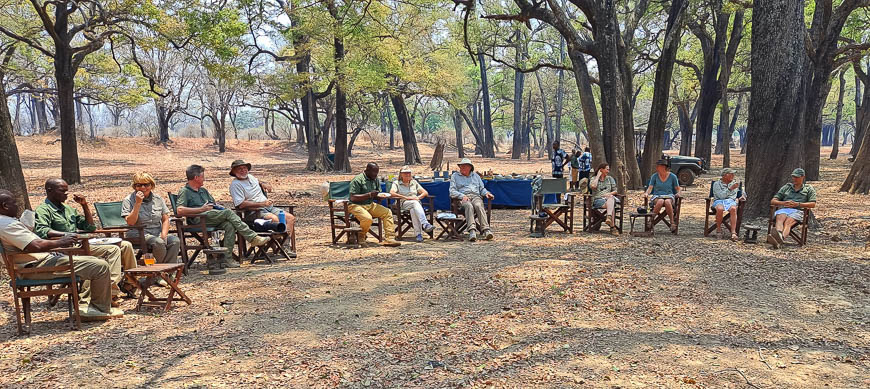
On our final full day at Shenton Safaris they laid on a beautiful bush lunch in the ebony grove for all the guests. It was a huge effort by the team and really appreciated by us all!
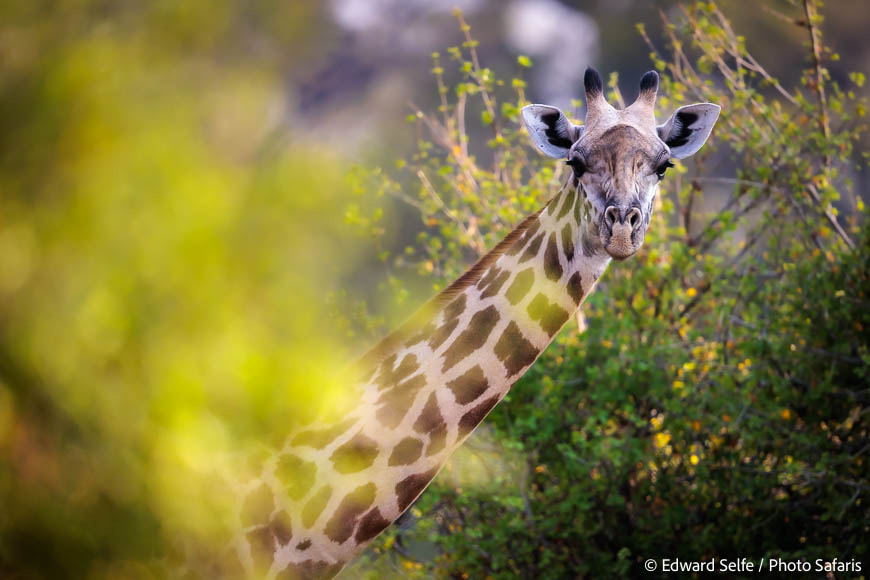
Placing some foliage in the foreground of this shot makes a very dull image of a giraffe into something more appealing. Looking for moments like this, and lining them up for the guests is a key element of a photo safari.
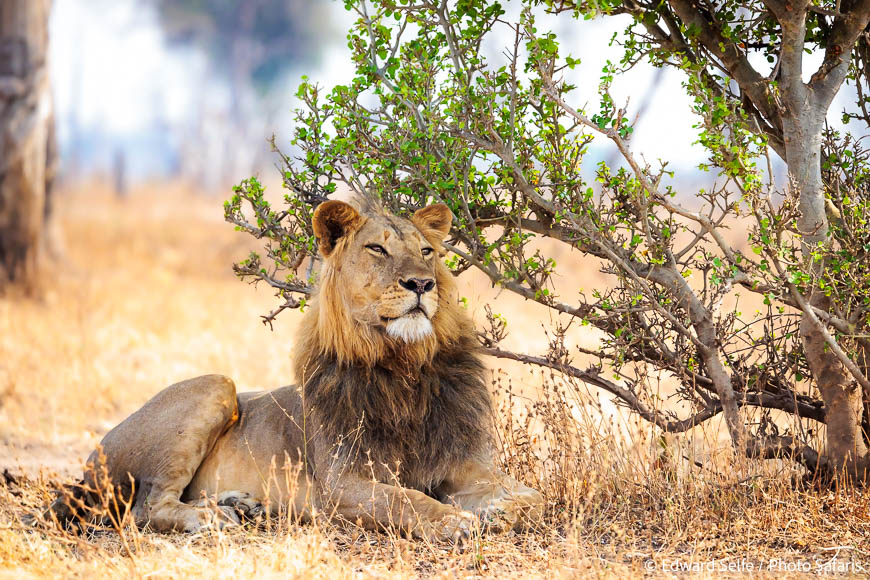
We were heading to the Mwamba last waterhole hide that day and found the Mwamba Pride on route. We took some shots and then drew back as they appeared to be hunting along the Mwamba River. However, the large number of cubs, and a reluctant male made their attempts look quite amateur. Lions benefit from the cover of darkness to pursue small, fast prey such as puku and impala.
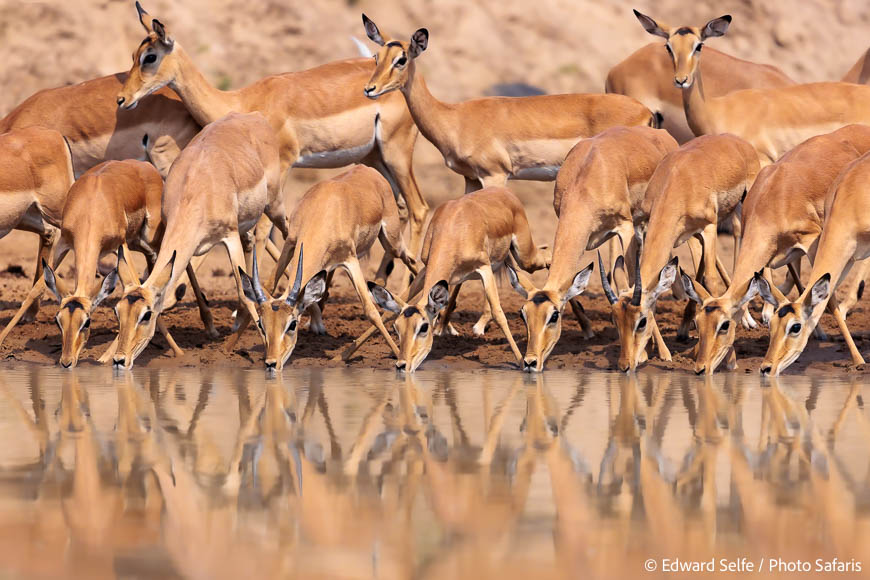
Mwamba’s last waterhole hide is just behind the camp and has several sections. As well as getting you very close to the wildlife that comes to drink, there are also low level sections which allow for almost mirror-like views across the water….
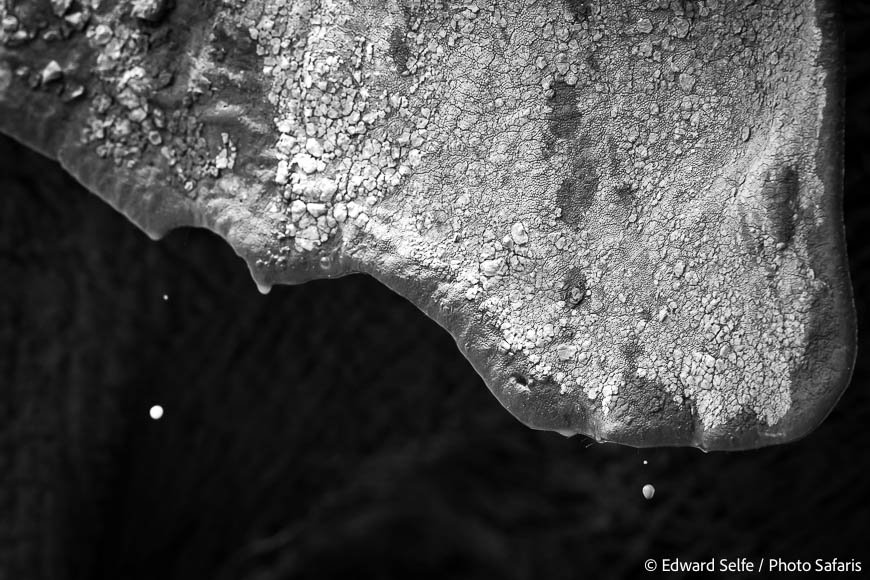
…and when I say close….
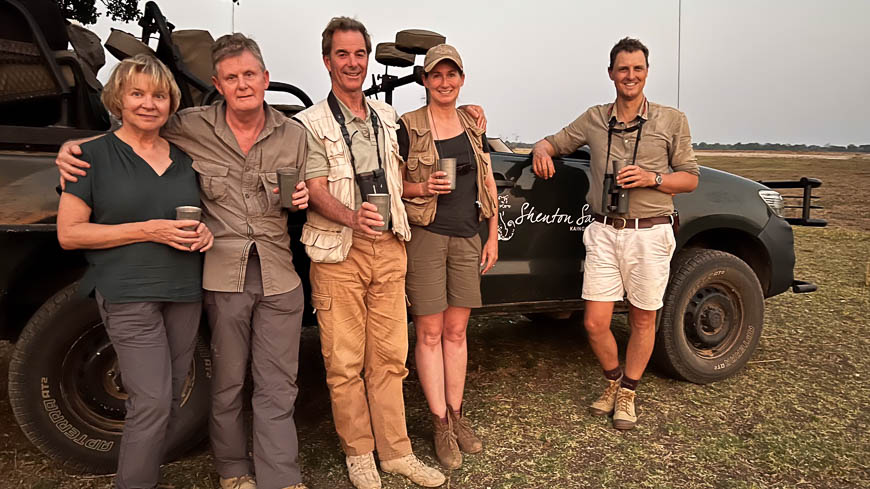
Sundowners, post sunset as always, when the light has gone….!
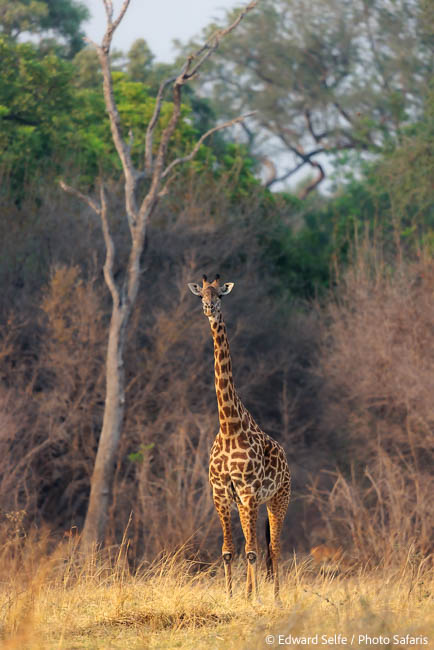
Our final morning at Shenton Safaris was a bit slow going. A compliant giraffe in stunning light….
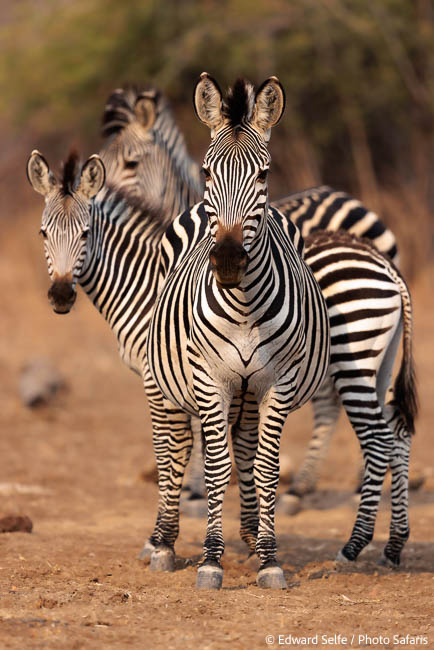
…a twitchy family of zebra and some plains game. But there was a lack of energy in all the sightings. I don’t pursue predators for the sake of predators, but that is often where there is action, interaction and movement since predators elicit those behaviours in prey…so I took the chance of heading to the location of the Hollywood Pride to see if they had moved on from the buffalo carcass.
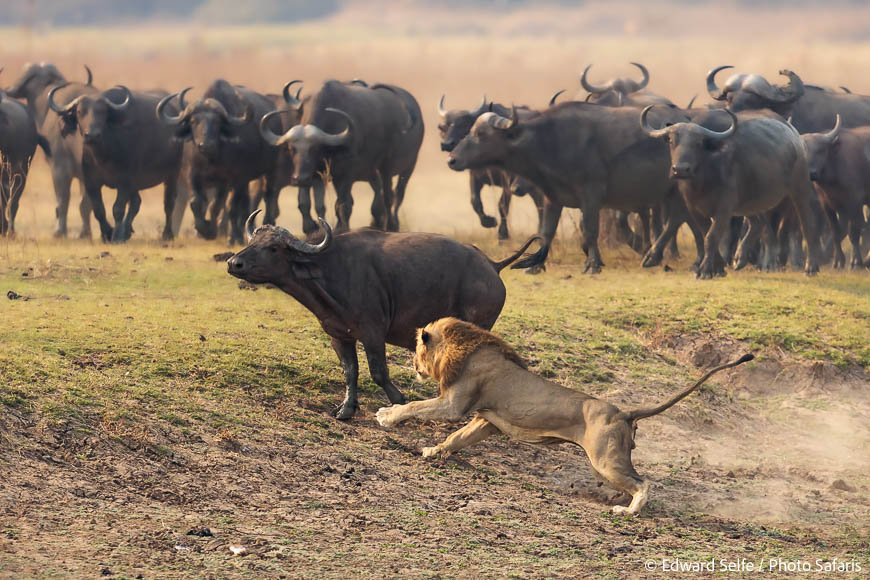
Well it turned out to be my best decision of the safari! As we rounded the corner that would reveal the grassy floodplain where the lions had been, we saw them all stalking through the grass towards an unseen target to our right. As we got closer, with a wider view, the target was revealed to be a small herd of buffalo! The male was leading the charge….
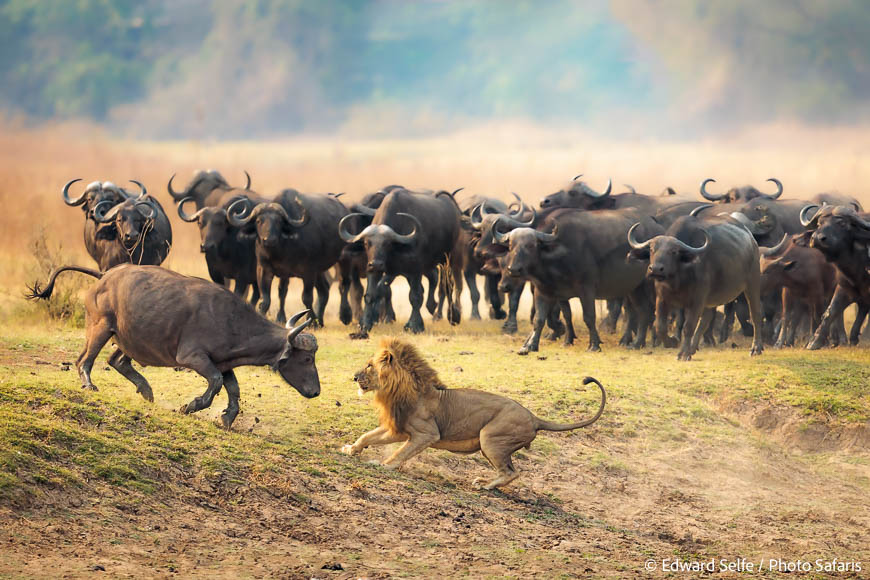
…and came eye-to-eye with the buffalo on several occasions. The bravery on show by both predator and prey was astonishing.
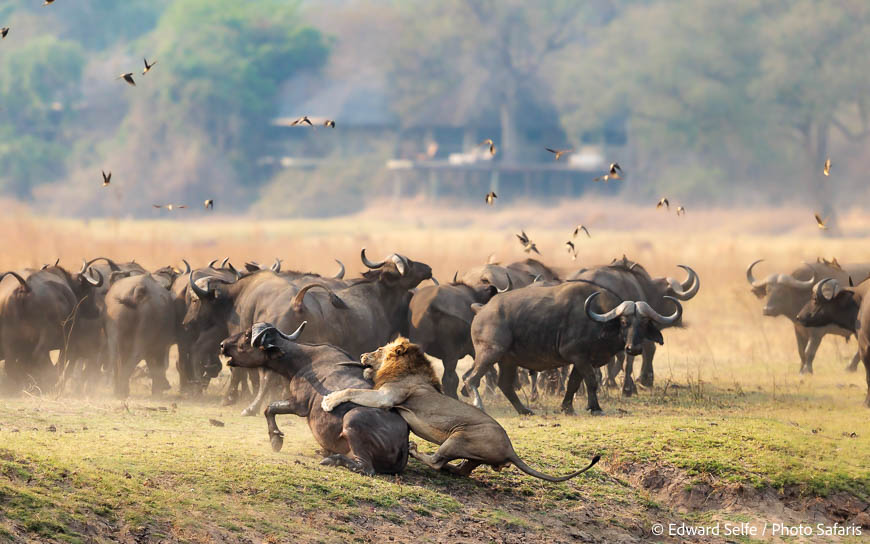
The male managed to drag down this female, but the lionesses were not close enough to hold off the rest of the herd and….
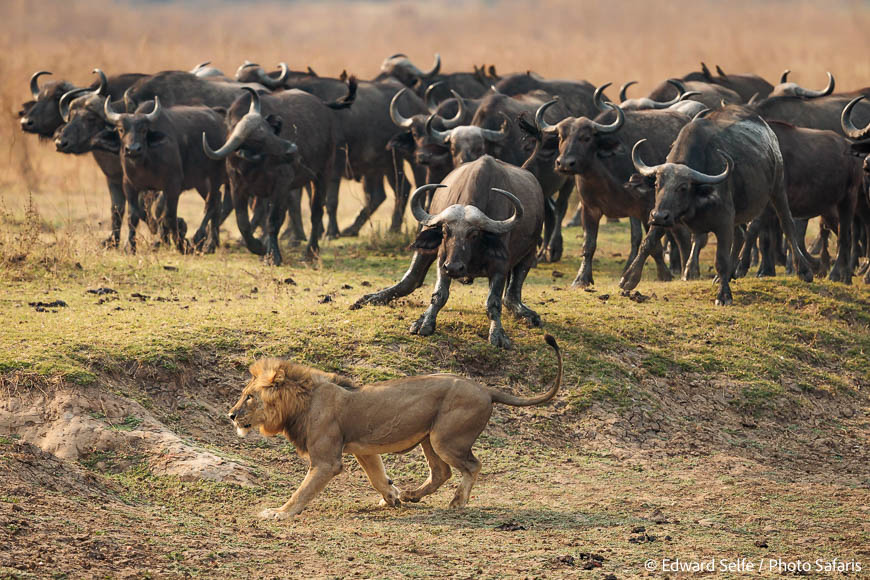
….the male was forced to release when the buffalo coordinated their response and chased him off.
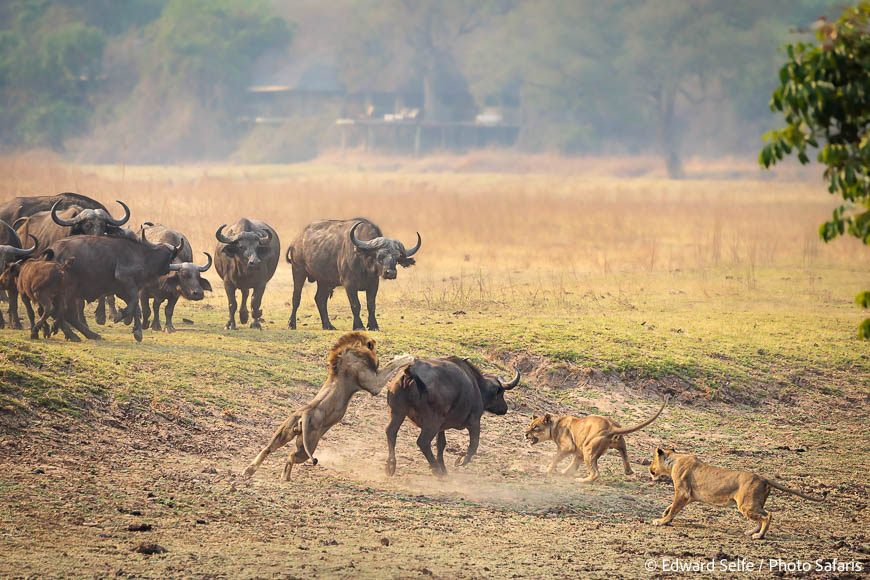
Again the male launched an attack and the females were with him this time; but the lines of horns approaching from above them made the lions reconsider.
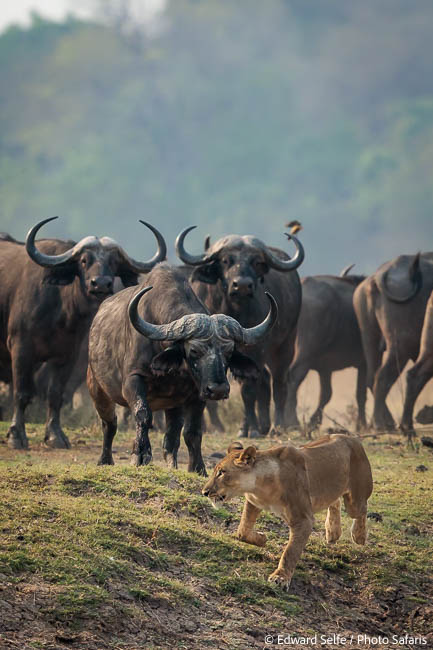
It was a very evenly-matched battle. The male lion was amazing, throwing himself on the backs of the buffalo cows and dragging them down. The lionesses, in fact, were perhaps the ones who didn’t play their part, failing to hold back the phalanx of horns at the vital moments.
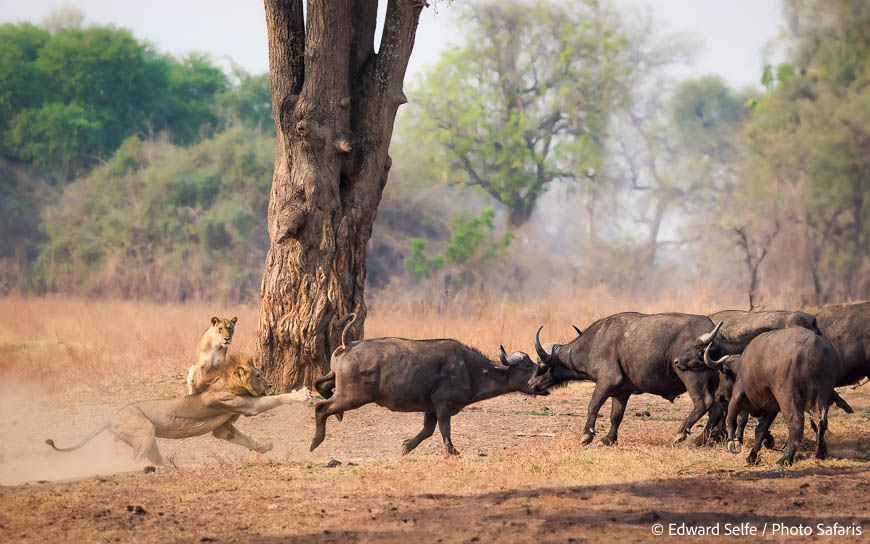
The action moved across the plain and we followed. There was one more challenge by the male but his commitment was dwindling and it was clear the buffalo would win this one. It had been 90 minutes of phenomenal action, but the end result was a win for the herd which held the lions back in a series of remarkable displays of individual and collective bravery.
We were late for our boat crossing to Nsefu Camp for our final 3 nights of the trip. Any photo guide will know that the best sightings happen when you are short of time, or on the way to the airstrip! The action was settling down so we headed to the crossing point, arriving in time to cross over to the wilds of the Nsefu Sector.
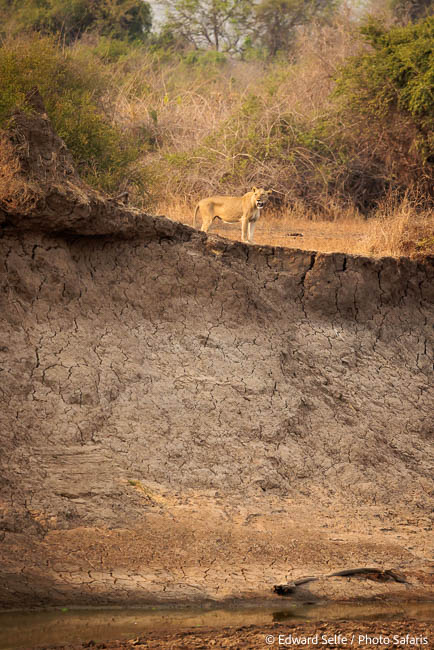
I wasn’t sure how to top that sighting, but I decided that searching for the leopards of the Nsefu wafwa would be a good place to start! However, as we reached the Croc River we bumped into 2 lionesses hunting a kudu…we positioned ready for the action but the antelope got the lions’ wind and scattered.
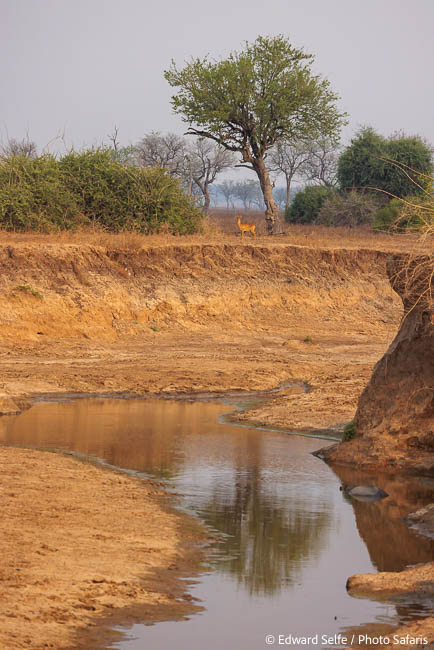
Turning to follow the lions, I spotted this beautiful scene of a puku standing in just the right spot for a Croc River landscape scene. It would be even better with a lion on the beach below…!
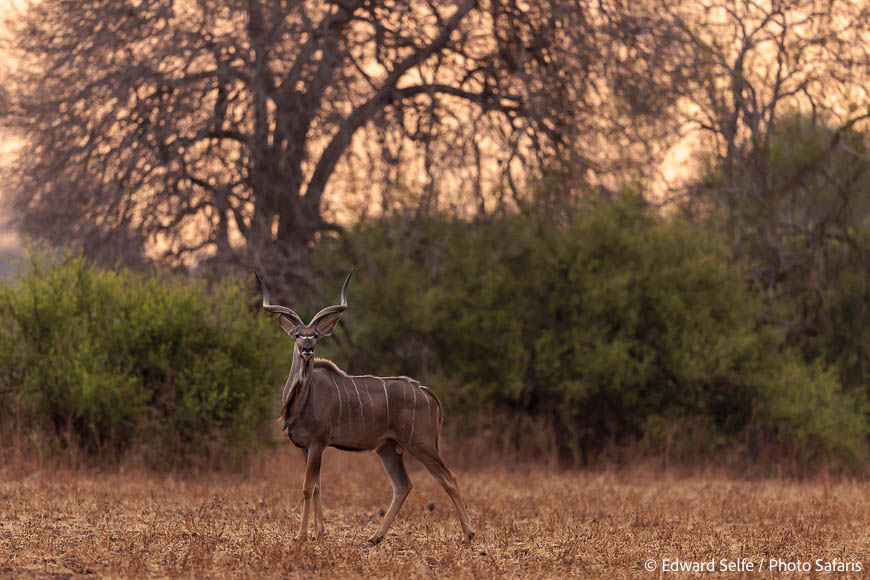
…we couldn’t find the lions immediately, but the kudu were still around. The light at this time of year can be very eerie….giving an almost smoky effect to images.
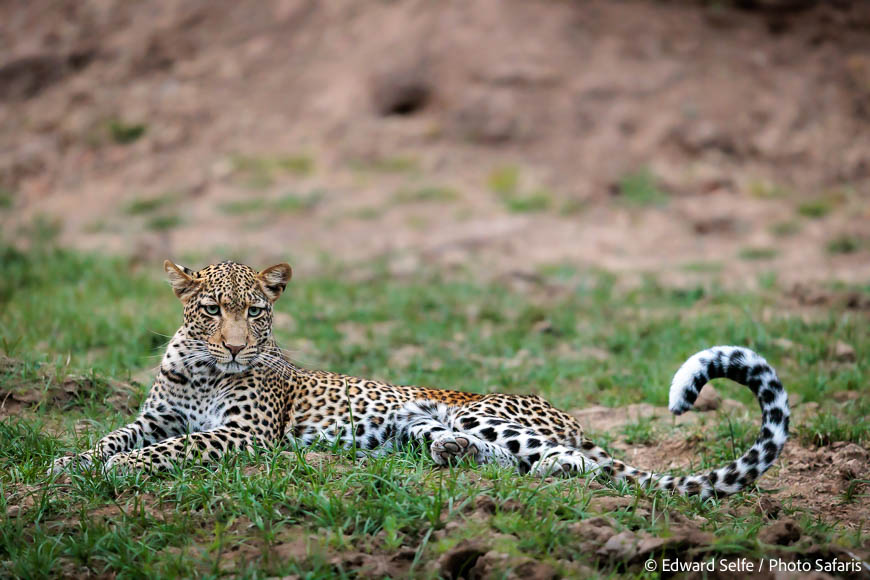
Moving on, we met with Mutima, a young leopard born in early 2021, who lives near the Croc River crossing. She is the daughter of Olimba and is in territorial dispute with her mother as she reaches adulthood. As such, her movements are hard to predict as she has, in the past, had an altercation with her mother and been found 15kms away a few days later! Her distinctive orange heart-shaped patch is visible on her left flank.
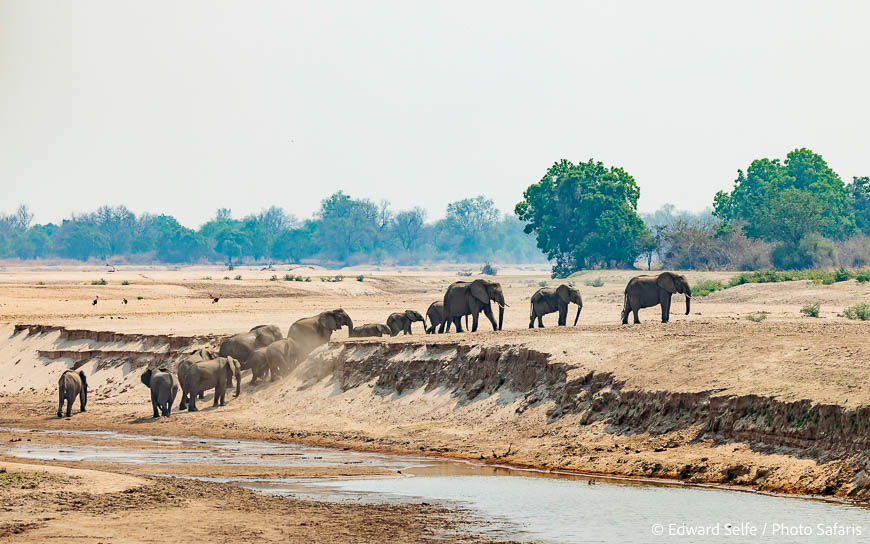
We searched for Olimba the next day, reaching the Chimbwi Lagoon area. Nearly 100 elephants were approaching the river to drink. Getting a clear composition in these situations is key; when all the elephants were drinking, it was too messy and chaotic, but as they climbed the bank to leave, there developed a beautiful ‘flow’ in the frame.
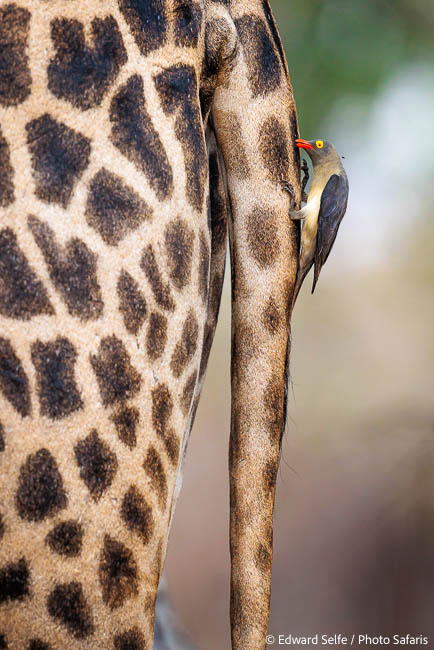
Getting close up with a giraffe and its attendants.
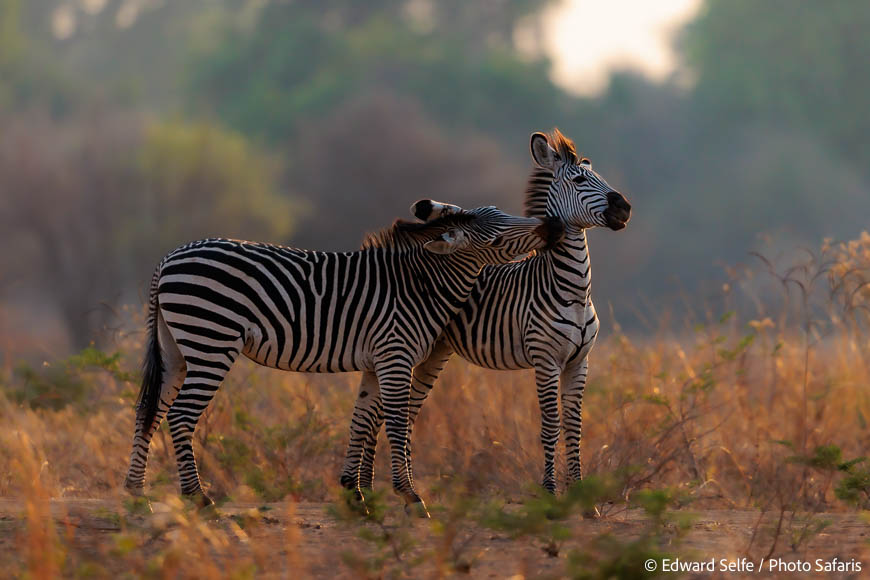
Epic light the following morning at the Stork colony….
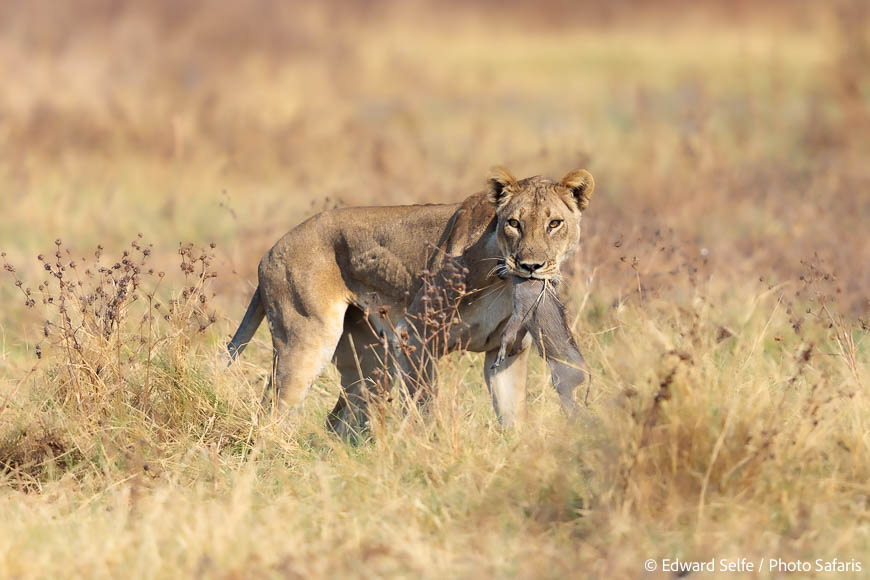
…on our way to the Salt Pans. On arrival at the Salt Pans, we found two lionesses resting in the shade. We decided that they wouldn’t be very active and were just about to move on, when their heads dropped and they entered hunting mode….a family of warthogs was running directly towards them in search of water. The warthog sow had 3 piglets…which quickly became 2…..
We did manage to find Olimba which was a major aim of the last part of the tour. She had been elusive because she’d killed a baboon several days before and had been happily eating it in a very well concealed tree! It wasn’t an easy view but we had a thrill as she walked past our vehicle on the way to the tree! She’s a real star and, as she gets older, it’s a privilege to see her each time, knowing that at some stage, the rainy season may be too much for her and she won’t reappear the following dry season. But for now, she’s fit, well and every bit the superstar she always has been.<\p>
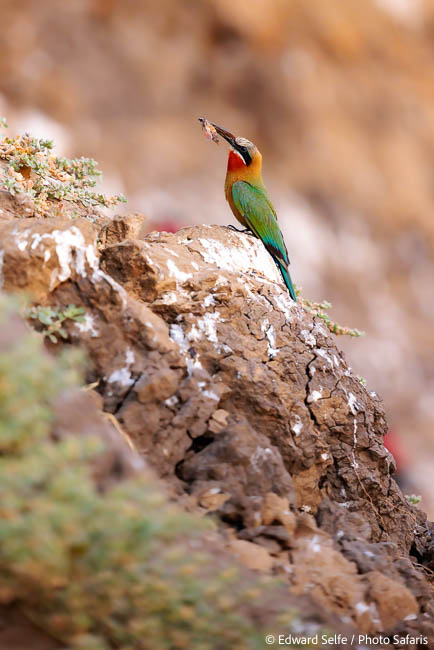
That was quite a way to end our tour; we had time the following morning to explore the carmine bee-eater hide near Nsefu Camp before heading to the airport. Sadly the birds were very skittish, but this white-fronted bee-eater sat nicely with its moth prize.
Thank you to David, Ute, Charles and Nathalie for sharing such a fantastic trip. I hope our paths cross again some day. And thank you to you for reading all the way to the end. As I write this, I am heading towards a Christmas break from 24 Dec – 8 Jan and I wish you all a very Happy Christmas.
My 2024 Season is almost fully booked with just a couple of spaces remaining. I will begin planning for 2025 in the New Year; you can expect many of the tried and tested destinations (and after writing this report I am happy that they will continue to feature) but also a number of new ones. Please get in touch if you would like to discuss more!

